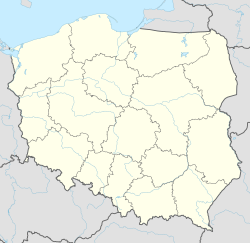Wołczyn
Wołczyn | |
|---|---|
 Saint Thérèse of Lisieux church | |
| Coordinates: 51°1′6″N 18°3′25″E / 51.01833°N 18.05694°E | |
| Country | |
| Voivodeship | Opole |
| County | Kluczbork |
| Gmina | Wołczyn |
| Town rights | 1261 |
| Area | |
• Total | 7.47 km2 (2.88 sq mi) |
| Elevation | 170 m (560 ft) |
| Population (2019-06-30[1]) | |
• Total | 5,907 |
| • Density | 790/km2 (2,000/sq mi) |
| Time zone | UTC+1 (CET) |
| • Summer (DST) | UTC+2 (CEST) |
| Postal code | 46–250 |
| Area code | +48 77 |
| Vehicle registration | OKL |
| National roads | |
| Website | wolczyn |
Wołczyn [ˈvɔu̯t͡ʂɨn] (German: Konstadt) is a town in Kluczbork County, Opole Voivodeship, southern Poland, with 5,907 inhabitants as of 2019[update]. According to 2011 data, it covers 7.47 square kilometres (2.88 square miles),[2] and is the seat of Gmina Wołczyn. It is located within the historic region of Lower Silesia.
History
[edit]The name of the town is derived from the Polish word wół, which means "ox". In the early 14th-century Liber fundationis episcopatus Vratislaviensis the town appeared under the Latinized name Welczyn. The town was probably founded on the site of a former Slavic settlement.[3] It was granted town rights in 1261.[3] It was part of various duchies of fragmented Poland. Until 1294 it was part of the Duchy of Wrocław, afterwards the Duchy of Głogów until 1312, Duchy of Namysłów until 1320, Duchy of Oleśnica until 1343, Duchy of Brzeg until 1436 and afterwards the Duchy of Oleśnica again. It remained under the rule of the Piast dynasty until 1495, and afterwards, for about 300 years, the town was owned by the magnate Posadowski family,[3] under the suzerainty of the Jagiellonian-ruled Bohemian (Czech) Kingdom until 1526, when the Habsburgs inherited the Bohemian Crown.
The town was located on a trade route connecting Kraków and Wrocław. The population made a living from agriculture, crafts and trade.[3] Five annual fairs were held in Wołczyn, and crops and handicrafts were sold to customers not only from Silesia, but also from neighboring Greater Poland.[3] In the 15th century the Czech Hussites and in the 17th century Polish Brethren settled in Wołczyn.[3] In the 16th century, a municipal school known for its high level of education was established there, and in the 18th and early 19th centuries there was a well-known proseminar for Polish Lutherans, later moved to Kluczbork.[3]
In 1742 the town was annexed by the Kingdom of Prussia. On 1 October 1868, the town was connected to a railway line. By 1907 Wołczyn had a water supply network.[3] In the final stages of World War II, on 19 January 1945, a German-organized death march of Allied prisoners of war from the Stalag Luft 7 POW camp passed through the town.[4] From 19 to 21 January 1945, fights were fought for the town between Nazi Germany and the Soviets.[3] As a result, 40% of the town's buildings were in ruins.[3] At the end of the war, the German population of the town was expelled in accordance with the Potsdam Agreement, and the town became again part of Poland. The remaining Poles were joined by Poles displaced from former eastern Poland annexed by the Soviet Union.[5]
Since 1994, the town has hosted an annual "Spotkania Młodych" (Meeting of Youth). It is organized by the Order of Friars Minor Capuchin.
Twin towns – sister cities
[edit]See twin towns of Gmina Wołczyn.
References
[edit]- ^ "Population. Size and structure and vital statistics in Poland by territorial division in 2019. As of 30th June". stat.gov.pl. Statistics Poland. 2019-10-15. Retrieved 2020-02-14.
- ^ "Powierzchnia i ludność w przekroju terytorialnym w 2013 r." Archived from the original on 2013-12-20. Retrieved 2010-08-20. "Powierzchnia i ludność w przekroju terytorialnym w 2011 r."
- ^ a b c d e f g h i j "Historia Wołczyna". Oficjalny portal Miasta i Gminy Wołczyn (in Polish). Retrieved 8 October 2019.
- ^ Stanek, Piotr (2015). "Stalag Luft 7 Bankau i jego ewakuacja na Zachód w styczniu 1945 r.". Łambinowicki rocznik muzealny (in Polish). 38. Opole: 65. ISSN 0137-5199.
- ^ Sword, Keith; Iglicka, Krystyna (1999-02-12). The Challenge of East-West Migration for Poland. Springer. ISBN 978-1-349-27044-6.
External links
[edit]- http://www.wolczyn.pl/
- Jewish Community in Wołczyn on Virtual Shtetl




